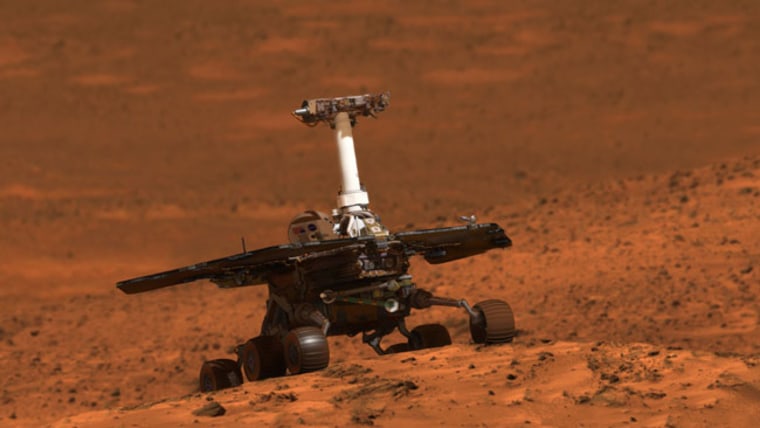NASA's Opportunity rover is chugging toward some interesting mineral deposits on the rim of a fresh crater on Mars, guided by a sharp set of eyes from above.
Opportunity arrived at Mars' Santa Maria crater in the last few days, and it should make it to the crater's southeast rim in a few weeks. Once there, it will investigate a patch of minerals that likely formed in the presence of water billions of years ago, researchers said here on Thursday during a press conference at the 2010 fall meeting of the American Geophysical Union.
The rover knows where to look thanks to NASA's Mars Reconnaissance Orbiter, which detected the minerals, known as hydrated sulfates, from 150 miles (250 kilometers) up while circling the Red Planet. This level of teamwork between rover and spacecraft is unprecedented, researchers said.
"It's the first time we've used minerals detected from orbit to drive where a rover should go," said Mars Exploration Rover deputy principal investigator Ray Arvidson, of Washington University in St. Louis.
The rim of Santa Maria
MRO detected the hydrated sulfates on Santa Maria's rim using its mineral-mapping spectrometer. Opportunity wasn't too far away, so the rover team decided to send the rover over for a closer look, researchers said.
The Martian surface is bone-dry today, but hydrated sulfates and clays which also form in the presence of water reveal that the planet was once a much wetter place. But that was long ago; scientists think the clays are 4 to 4.5 billion years old and the hydrated sulfates are about 3.8 billion years old.
Craters provide a way for scientists to probe such ancient rocks, which would otherwise remain buried and out of reach.
"These are nature's drills to expose the bedrock," Arvidson said.
And Santa Maria is special as far as craters go, he added. The crater appears to be extremely young in the geological scheme of things perhaps just a few million years old, Arvidson told Space.com — so its surface hasn't been too grimed over by weathering.
"We've never seen a crater this fresh, this big," Arvidson said.
Opportunity should soon get a good, up-close look at the minerals on the southeast rim. When it gets to the area in the next few weeks, the rover will verify MRO's orbital observations and also collect more in-depth data, researchers said.
On the way to Endeavour
The Santa Maria stop marks a slight detour for Opportunity, which is making its slow, steady way to a giant crater called Endeavour.
The rover turned its wheels toward the 14-mile-wide (22-kilometer-wide) Endeavour in the summer of 2008. Opportunity has since covered about 9 miles (14.5 kilometers), with about 3.7 miles (6 kilometers) left before reaching the crater, researchers said.
And MRO will help guide Opportunity the rest of the way. The orbiter has detected clays at Endeavour, and it has found clays and hydrated sulfates at various other spots, helping scientists plan Opportunity's route. The goal is to investigate and characterize the ancient Martian environment, to help determine if the planet may ever have been capable of supporting life, researchers said.
Opportunity and its twin rover, Spirit, both landed on Mars in January 2004. Their mission was initially slated to last only about three months, but both have far surpassed that lifetime. [Photos from Spirit and Opportunity]
Last year, Spirit got bogged down in soft sand, and it stopped communicating with Earth in spring 2010. NASA officials haven't given up hope of hearing from the rover, though.
"We're listening now," said rover project manager John Callas, of NASA's Jet Propulsion Laboratory in Pasadena, Calif. "We've been listening every day."
But Callas said that pessimism is definitely in order if Spirit hasn't made a peep by March, when the Martian sun will be strong and the rover will have had plenty of chances to warm up and power up.
